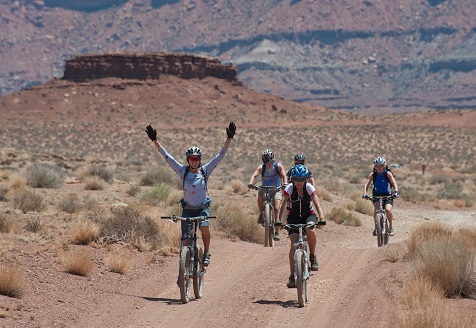Biking & Bone Health – How My Passion Inspired a Bone Supplement
March 17, 2017
 The sun was out, the wind in my face and I was feeling strong coming into the home stretch of my morning bike ride. I was training for an upcoming triathlon and had been logging a lot of miles every week on the bike. For over 20 years, cycling was one of my most favorite activities, however this morning ride would take a different turn. Coming around a sharp turn at high speed I hit a frosty patch of pavement and went down hard. The crash left me and my bike badly scraped up, and I had a broken rib. I put my cycling routine on hold while my body mended itself. I was a little surprised by the break though: I’d been lifting weights and eating a healthy diet, and I just assumed my bones were sturdy. So I decided to check my bone density.
The sun was out, the wind in my face and I was feeling strong coming into the home stretch of my morning bike ride. I was training for an upcoming triathlon and had been logging a lot of miles every week on the bike. For over 20 years, cycling was one of my most favorite activities, however this morning ride would take a different turn. Coming around a sharp turn at high speed I hit a frosty patch of pavement and went down hard. The crash left me and my bike badly scraped up, and I had a broken rib. I put my cycling routine on hold while my body mended itself. I was a little surprised by the break though: I’d been lifting weights and eating a healthy diet, and I just assumed my bones were sturdy. So I decided to check my bone density.
“James, you have Osteopenia,” my Rheumatologist said. The words sent chills through my apparently brittle bones. I asked him. “What do you recommend I do?” He replied, “I could start you on a medication.” I decided instead to take matters into my own hands and began to focus on diet and exercise for bone building, not just heart health.
Unfortunately, my research revealed disturbing data about the detrimental effects of chronic strenuous cycling on the skeleton. Professional cyclists such as those riding in the Tour de France have been shown to lose substantial bone density in the lumbar spine even just during the month-long race. Prolonged bouts of high-intensity endurance exercise in a weight-supported position like bike riding can cause erosion of bone strength. Even more disturbing were the studies linking standard calcium supplements to an increased risk for coronary disease and heart attack. And I wasn’t crazy about cow’s milk because I’m lactose intolerant. Still, I knew that in order to build bone one should ideally be consuming at least 1,000 mg of calcium per day.
Reduced bone density, in the form of osteoporosis (significant reduction) or osteopenia (mild reduction) affects almost one out of two U.S. women and men over age 50. This silent epidemic usually festers under the radar until it blows up in the form of painful and sometimes deadly fractures. For people over age 65 fractures are the most common cause of hospitalization, nursing home admission, and death.
I seemed to be between a rock and hard place. Hard arteries and soft bones were two of the most common causes of death for us Americans, but the treatment to harden bones – calcium - seems to worsen heart disease risk. To solve these kinds of conundrums I have learned to rely on Mother Nature; she’s usually already devised safe and proven strategies to keep us strong and healthy. So I delved into the studies about the diets of our ancient ancestors.
Adult human hunter-gatherers consumed most of their calcium in the form of bones from animals, including small and large mammals, birds, fish, and reptiles. Indeed through millions of years of evolution, we are genetically adapted to consume a large proportion of our dietary calcium from bones, where calcium is absorbed along with a matrix of nutrients including magnesium, phosphorus, strontium, zinc, iron, copper, collagen protein, aminoglycans, and osteocalcin - all of which also support robust bone formation.
Consuming organic bone meal is an ideal strategy to ensure adequate dietary calcium. MicroCrystalline HydroxyApatite (MCHA) (the form of calcium found in bones and bone meal) unlike standard calcium supplements, doesn’t cause an acute spike in blood calcium levels and thus does not appear to calcify arteries or increase the risk of heart attack.
Placebo-controlled randomized trials show that calcium from bone meal in combination with vitamin D and vitamin K2 supports bone density, whereas standard calcium supplements at best only cause a slowing of further bone loss.*
That’s why I, along with my wife Joan, who had her own reasons, decided to create Bone Essentials, a natural product with all of the above ingredients. I wanted to support stronger bones while maintaining the health of my arteries as well. It’s as if you were eating bones with your diet - like humans did for eons before the first McDonalds restaurant opened.
After taking Bone Essentials for 2 years I went back to the Rheumatologist who was so impressed with the results that he assumed I had been taking a prescription medication for bone building. The beauty of Bone Essentials is that it’s a natural way to maintain bone strength for your long term health and longevity. A well-balanced diet, weight lifting, weight-bearing exercise and Bone Essentials have helped me normalize my bone density and reduced my chance of developing Osteoporosis - it’s my plan and I’m sticking with it.
In Good Health,
James O'Keefe, MD





